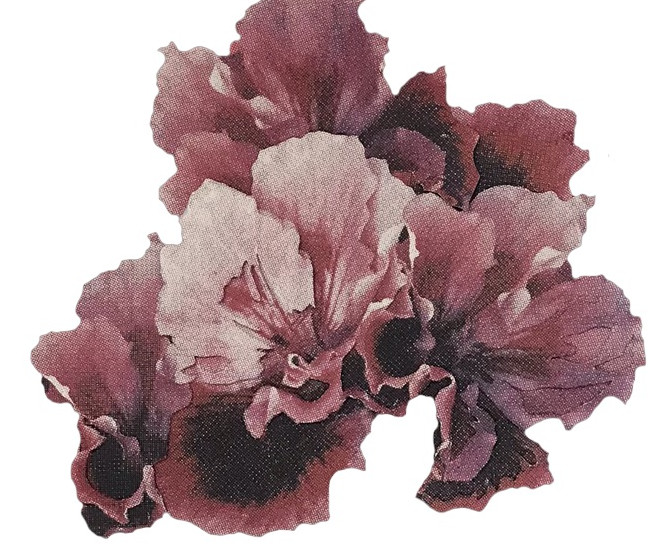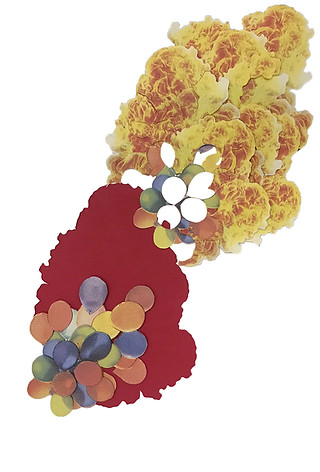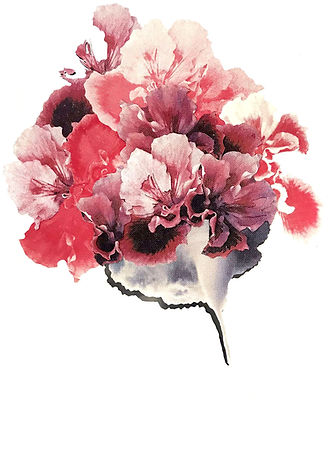


Artist Statement
As a young, female, South African artist, my work is heavily influenced by my immediate surrounding and daily encounters. Stemming from a particular trauma and scarring. I look at botany and flora as a way to discuss certain portraits of women.
In the context of a rape culture, I use flowers as metaphors for women' bodies. I acknowledge the wilted state of damaged bodies, but incorporate flowers in full bloom, focusing on the power and strength that results from trauma and pain. My work subverts a hierarchical Patriarchy that dominates and runs through the veins of society - a concurrent feeding and wilting.
-2018
Pain and Power


Pain and Power: The Strength and Power of a Woman,
2018
Time-lapse video (00:36)
Pain and Power: Ouroboros,
2018
Time-lapse video (00:22)





InsideOut




Water source



Concepts explained
Inside Out
Trauma that effects the mental aspect of a person is often difficult to detect because of the lack of obvious, visual signs on the exterior of the body. This often leads to the dismissal, misunderstanding, and ridicule of mental damage.
Looking at the relation between mind and body, the series of three prints explores the effects of trauma.
The original prints of Inside Out show the juxtaposition of earthly elements in destruction with that which we recognise and beautiful and seemly - colourful flowers and balloons, and a woman’s body.
The screen printing process in CMYK layers creates the image in four different layers of colour. This is relevant when testifying the complexity of trauma from body through to mental.
The reworked version of Inside Out is a result of further experimentation and investigation. The concept remained one that addresses the idea of ignorance, misunderstanding, trauma and damage.
The ignorance that the reworked prints addresses is that from micro-aggressions that form the basis of a rape culture. Each reworked print is assigned individual titles that were influenced by an encounter I had with a man.
The first two are quoted from the man: “Do you have a boyfriend?” And, after my response of no, his reply “Oh so you don’t mind if I invade your space then.”
The last title, This is MY space!, is my response that I was not able to give at the time; formed from a place of catharsis.
“Do you have a boyfriend?” and “Oh so you don’t mind if I invade your space then.” show destructive elements intruding and opposing. This is MY space!, however, shows a shift in dominance and power.
The symbolic flowers (referring to myself) have outsized the destructive force (oppressive patriarchal micro0aggressions that objectify women with the belief that a woman’s personal space should only be respected if she is committed to another man - ergo his possession).
Pain and Power
Pain and Power is a series that includes two time-lapse videos and five screen prints. Through a qualitative approach to a section in my corresponding research paper, I asked four women a set of eight questions around the theme of pain, power, and their body.
This series was created in response to South Africa’s prevalent rape culture and the trauma that women experience because of it. The toggle between wilting to depletion and rising to full bloom is one that coincides with the nature of time and the distribution of power. The relation between mind and body is also a prominent theme throughout.
With photographs from the time-lapse videos and the visual responses from the four women, I created five different collage images that were translated into screen prints.
Pain and Power: The Strength and Power of a Woman, 2018, time-lapse video (00:36) - The use of the indigenous South African Protea flower represents hardiness and perseverance, especially when considering the climate and environment in which these flowers grow. Each white rose represents the five specific stories that the ‘Pain and Power’ series embodies and the ability of each woman to rebook with only the small price of scars to show.
Pain and Power: Ouroboros, 2018, time-lapse video (00:22) - Ouroboros is a symbol that shows a snake devouring its own tail. Representing the eternal cycle of nature, this symbol also suggests constant rebirth. This video and title is inspired by the snake tattoo on the forearm of a woman. Just as the snake is constantly reborn, so is the South African in digamous Arum Lily re-erected in full bloom at the end of the video.
Pain and Power: “Scars remind me that I healed”, 2018, screenprint on 200gsm, 30x42cm - The title is quoted from one of the interviewed women. The print is based on the pattern of the most prominent scars that remain on my left wrist.
Pain and Power: Power found through Pain, 2018, screenprint on 200gsm, 30x42cm - This print is a translation of South AFrica’s frightening rape statistics. Whilst the wilted, white roses represents two specific experiences of rape, the hardy, indigenous Protea flower represents the resilience of South African women. The amount of woman that have been raped in South Africa is a testament to the pain and fear that so many women endure and live with.
Pain and Power: “the Sensuality and Beauty of being a Woman”, 2018, screenprint on 200gsm, 30x42cm - The print is in celebration of this woman who learnt the sensuality and beauty of being a woman once she had come to terms with her rape. It showcases her tattoos, each one representing a different chapter in her life, that allowed her to learn to love herself by turning her body into a work of art.
Pain and Power: Different stories, Same Struggle, 2018, screenprint on 200gsm, 30x42cm - The array of different flower species in this print suggests women of all backgrounds. A flower, regardless of specie, will wilt and die if denied of a water source. This print suggests a hierarchical patriarchy as being in control of the water source.
Pain and Power: Hungry for Perfection, 2018, screenprint on 200gsm, 30x40cm - This print represents the result of societal pressures on women to behave and look a certain way. The juxtaposition go the wilted roses with the woman’s nutrient-deprived body assimilates the process of wilting flowers to the effects of trauma; suggestive of a concurrent feeding and wilting through the veins of a hierarchical society.
Water source
Continuing from Pain and Power, Water source documents and explores the wilting process of the flowers through photography, time-lapse videos, and screen prints.
What is the water? How does it go through the veins? Where does it go when the flowers wilt? What else is absorbed through the veins? Is the water life-giving, life-taking, or both? How does the water affect the flowers in its different forms?
What is patriarchy? How does it dominate society? Where are women placed in this patriarchal hierarchy? How does it affect women? What are the different ways that sustain this hierarchy? What are the different forms of oppression that is experienced in this hierarchy?
Water source consists of screen prints from photographs of the flowers before and after the various wilting processes, and a time-lapse video.
Flowers are the dependent variable.
Water is vital and life-giving.
Ice is preserving,
but no flower is alive when frozen.